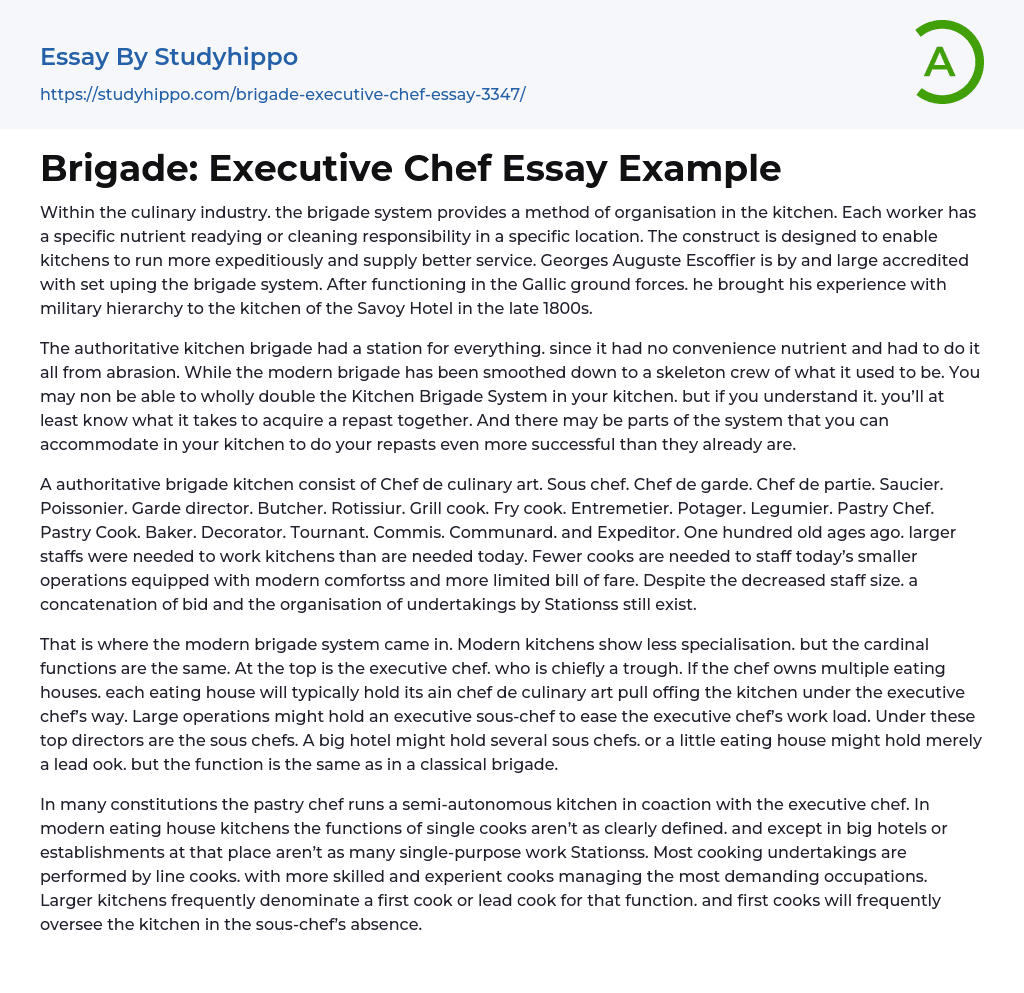The brigade system is utilized in the culinary industry to organize the kitchen, with each worker having specific duties related to preparing or cleaning in a particular location. This framework is designed to improve kitchen efficiency and provide better service. The credit for establishing the brigade system is typically given to Georges Auguste Escoffier, who adapted his experience with military hierarchy from serving in the French army to the kitchen of the Savoy Hotel in the late 1800s. The traditional kitchen brigade had positions for every task as they made everything from scratch, unlike modern kitchens which require fewer staff members. While it may not be possible to replicate the Kitchen Brigade System entirely, understanding it can help you create a successful meal. Some elements of the system can be adapted to your kitchen to make your meals even more successful.
...A classic brigade kitchen had positions for Chef de cuisine, Sous chef, Chef de garde, Chef de partie, Saucier, Poissonier, Garde manager, Butcher, Rotisserie chef, Grill cook, Fry cook, Entremetier, Potager, Legumier, Pastry chef, Pastry cook, Baker, Decorator, Tournant, Commis, Communard, and Expeditor. One hundred years ago, larger staffs were required to work kitchens than are needed today.Nowadays, smaller restaurants with modern amenities and a limited menu require fewer staff in comparison to the past. However, the process of assigning tasks by stations and bidding still remains and this is where the modern brigade system plays a role. Although modern kitchens have less specialization, the primary roles remain the same. The executive chef serves as the head supervisor. In cases wherein the chef has multiple restaurants under his/her ownership, each restaurant has its own
chef de cuisine who manages the kitchen under the executive chef’s direction. In order to reduce workload, large operations may have an executive sous-chef to help the executive chef. Below them are sous chefs, which can vary in number depending on the size of the establishment. Even in small restaurants, there is still an important role for lead cooks to aid the sous-chef when necessary. In many set-ups, particularly in pastry kitchens, the pastry chef oversees a semi-autonomous kitchen together with the executive chef. Individual cook roles are not as prominently defined as before, especially in modern restaurants, and there are fewer work stations for specialized tasks except in larger establishments. In most cases, line cooks perform most of the cooking duties with skilled and experienced ones handling the demanding tasks. Larger kitchens may have a designated first cook or lead cook who supervises in the sous-chef's absence.Novice cooks can start by assisting at busy stations in the kitchen or working independently at a less demanding station. In larger and some smaller kitchens, there are homework chefs who are responsible for basic tasks such as peeling, cutting, and preparing ingredients or making stock and sauces. This allows more experienced cooks to focus on more skilled labor. Prep cooks are also known as cooks' helpers, who constantly assist and manage a busy station during service. Apprentices are cooks enrolled in formal training programs who learn through a combination of on-the-job training and classroom instruction. They are typically given the opportunity to learn all positions in the kitchen, starting with prep work before moving on to the line. The dishwasher also plays an important role in the
kitchen by quickly returning used utensils to service and occasionally assisting with food preparation. Overall, both modern and traditional kitchens employ the same system, but as kitchens have become smaller and more modernized, the brigade has undergone some changes. Although the system remains the same, some chefs have been merged since fewer people are needed to run the kitchen.
- Beef essays
- Beer essays
- Beverages essays
- Bread essays
- Burger essays
- Cake essays
- Coconut essays
- Coffee essays
- Cooking essays
- Crowd essays
- Cuisines essays
- Dairy essays
- Desserts essays
- Dinner essays
- Drink essays
- Fast Food essays
- Favorite Food essays
- Food Safety essays
- Food Security essays
- Food Waste essays
- Fruit essays
- Ginger essays
- Hamburger essays
- Ice Cream essays
- Juice essays
- Lemon essays
- Meal essays
- Meat essays
- Oreo essays
- Organic Food essays
- Pizza essays
- Rice essays
- Sainsbury essays
- Sugar essays
- Taste essays
- Tea essays
- Wine essays
- Adoption essays
- Aunt essays
- Babies essays
- Bedroom essays
- Caring essays
- Children essays
- Daughter essays
- Divorce essays
- Dog essays
- Dysfunctional Family essays
- Family Tradition essays
- Family Values essays
- Father essays




